Dolphin Pregnancy Is a Drag, Literally

The extreme physical changes that come during pregnancy may be most evident in humans, but they plague other animals as well. New research shows that pregnant dolphins are so hefty the increased drag on the body makes them swim slower.
"They have this huge body and that creates a large frontal surface area and that drag is going to pull at them," study researcher Shawn Noren, of the University of California, at Santa Cruz, told LiveScience. "Swim performance is lower as well."
It's possible that this extra effort to swim fast could have an impact on the species' survival. If the pregnant dolphins can't escape predators or keep up with their group when chased by tuna fishermen, it could explain why the population isn't rebounding as quickly as expected, Noren said. (Groups of dolphins and groups of tuna tend to live in close proximity, so tuna fishermen chase down dolphins to get to the tuna that usually live below them.)
Dolphins in action

Noren filmed two pregnant dolphins at Dolphin Quest in Hawaii. They were nearly full term. She compared these videos with video taken two years after the pregnancy and found that not only did the larger fully pregnant females produce more drag as they swam through the water, their swimming technique was also altered.
An analysis showed that by having a greater surface area due to their pregnant bellies, which meant more water for the dolphins to push out of their way as they swam, the drag on their bodies increased by about 50 percent compared with their svelte, non-pregnant state.
"When this animal is not pregnant it can swim exactly twice as fast and get the same drag," Noren said.
Sign up for the Live Science daily newsletter now
Get the world’s most fascinating discoveries delivered straight to your inbox.
Because of where the baby dolphin sits (near the mama's tail) during development, the mothers also didn't have as much flexibility at near full-term. They couldn't flip their tails up and down as far as they could after giving birth, so they compensated by flipping their tails about 14 percent more often. [Infographic: How Long Are Animals Pregnant?]
"That whole second half of the animal's body is what the dolphins use to swim, and that fetus is sitting back there toward the back part of the tail," Noren said. "We measured the same animals after birth [of their baby], and they were moving their tail flukes higher when they weren't pregnant than when they were."
Predator chases
These weighed-down mamas might have more trouble outrunning predators (or tuna fishermen) in the wild. Noren notes that their wild predators, which include sharks and some whales, can reach speeds faster than these pregnant dolphins and so might be able to overtake them in a chase.
During these chases, fleeing either aquatic or human predators, young, sick or pregnant dolphins may lose their group, which, Noren said, "could explain why the population isn't recoveringat the expected rate."
This kind of pregnancy drag is likely present in every animal. Birds and land animals (and even insects) need to fight against gravity to keep moving, and as they grow larger this gets more difficult.
"Every animal has shown reduced performance [during pregnancy] and becomes quite sedentary," Noren said. Not many studies have been able to show exactly how much of a drag pregnancy can be.
The study was published Nov. 24 in the Journal of Experimental Biology.
You can follow LiveScience staff writer Jennifer Welsh on Twitter @microbelover. Follow LiveScience for the latest in science news and discoveries on Twitter @livescience and on Facebook.
Jennifer Welsh is a Connecticut-based science writer and editor and a regular contributor to Live Science. She also has several years of bench work in cancer research and anti-viral drug discovery under her belt. She has previously written for Science News, VerywellHealth, The Scientist, Discover Magazine, WIRED Science, and Business Insider.











